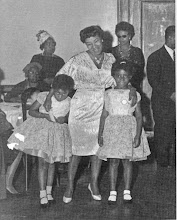
MJ, Brownie (Mrs. Brown), Aunt Barbara, Grandpa Andrew, Faith and Cousin Cheryl as Flower Girl in 1950 just arriving at Aunt Barbara's wedding. I guess I was intriqued by my Mom in glasses, still a teenager not yet contemplating the possibility of my existence. Also the clothes, all of which MJ made and Grandpa Andrew who so rarely figures in the photographs we have collected. I have heard so many stories about this particular wedding.

Meandering and quandaries in words and pictures. A quandary is a difficult situation, a practical dilemma. Meandering implies a circuitous journey, an ornamental pattern of winding or interlocking lines as in a mosaic. This is the picture of Aunt Barbara's extensive train, hand embroidered by her sister Faith.
And there are so many other pictures surviving of this marriage that didn't last, including my favorite, the picture of Aunt Barbara, Mom and their friends in (Mme. Willi Posey) Momma Jones' living room at 363 Edgecombe Avenue in the month of June and the year of 1950 serves to introduce Soul Pictures as a project, the meandering path of documents and photographs, the quandary of ongoing difficult situations in America. Being black in America. Being a woman in America in the 20s and the 30s and the 40s and the 50s.
This particular image is part of a collection of wedding photos taken at the time of Aunt Barbara's wedding to Jo Jo Knight. The unforgettable thing about the event of Aunt Barbara's wedding for me is that it was a wedding produced and designed by Momma Jones, my most beloved grandmother, my mother's mother. For the purpose of this project, I refer to her as MJ for short. MJ designed and made all of the clothing for the wedding, including Aunt Barbara's wedding gown, which still exists as part of Mom's archival collection of MJ's designs. Mom who was still a girl helped MJ to hand embroider the train, which is unlike any I have ever seen.
Sitting cross legged on the floor with a beautiful smile is my father-to-be, Earl Wallace, 23 years old and living then with his mother at 365 Edgecombe Avenue. Earl was a jazz pianist by profession and would play at Aunt Barbara's wedding with a combo composed of Edgecombe Avenue playmates Sonny Rollins and Arthur Taylor.
The handsome man to the left of Earl with his hands folded at his knees, staring off into the distance is Jo Jo, the groom to be. The union with Aunt Barbara would not turn out well and so I would never know him. The woman standing behind him laughing is Aunt Barbara, the same age as Earl, 23, and enchanting. On the right just behind the first male (who may have been a friend of Jo Jo's since no one seems to know who he is now) in the picture is Faith not yet 20 years old. Not married yet to Earl although they would marry quietly later that same year. Barbara, Faith, Earl and Jo Jo are encircled by their friends, their Sugar Hill, Edgecombe crowd.
Everyone is beautiful, young and transparently happy although these are by no means your usual carefree people. These are young black people in the 50s, not the bourgeoisie but what was the difference? Wherein lies the difference? I still have no idea how to pose that question, much less to respond to it but it has something to do with being black in Jim Crow America.
These pictures, Aunt Barbara's wedding pictures and all the other pictures which compose the photographic collection MJ left to Faith and which Faith has so carefully preserved, epitomize for me the scene into which I was born--the mood, the philosophy, the aesthetic, the concept of the self as an extension of a coherent community, albeit nonetheless largely invisible to the dominant culture of white supremacy.
Also in this picture is something else, which Amiri Baraka refers to in his Autobiography (1984) as "Black Brown Yellow White." As he writes poetically, "The brown was my family and me, half real and half lodged in dream and shadow."
Baraka writes so much wonderful stuff in this book, which together with Claude Browne's Manchild in the Promised Land, has helped me to imagine more fully the scene that existed around my vague but intoxicating memories of Edgecombe Avenue in the 50s when I was a girl.
The browns had to weave in betwixt and between the harshest disasters, getting cut in the street, locked up by police, living in places with smelly halls, having hair 'standing all over your head,' being 'Blue' (a nickname) or 'liverlips' or having a drunk father or mother or a falling-down house, or a tiny apartment decorated with rotogravure covers. Or failing in school, being left back, put back for being from the South, dropping out to go to work, having parents that couldn't speak 'good English.' Browns barely escaped all of this and actually had to be tested by yellows and whites or yellow and white 'reality' to see if they passed.
The way Baraka writes about his family and the streets and the music seems related to what I can remember too of Harlem in the early 50s although my own memories are comparatively the shadowy, elliptical recollections of a little girl who was not yet born until 1952 and Baraka was born in 1934 across the George Washington Bridge (which opened in that year) in Newark, New Jersey. The pictures the photographs and the music speak it as well as words ever could. At least to me.




